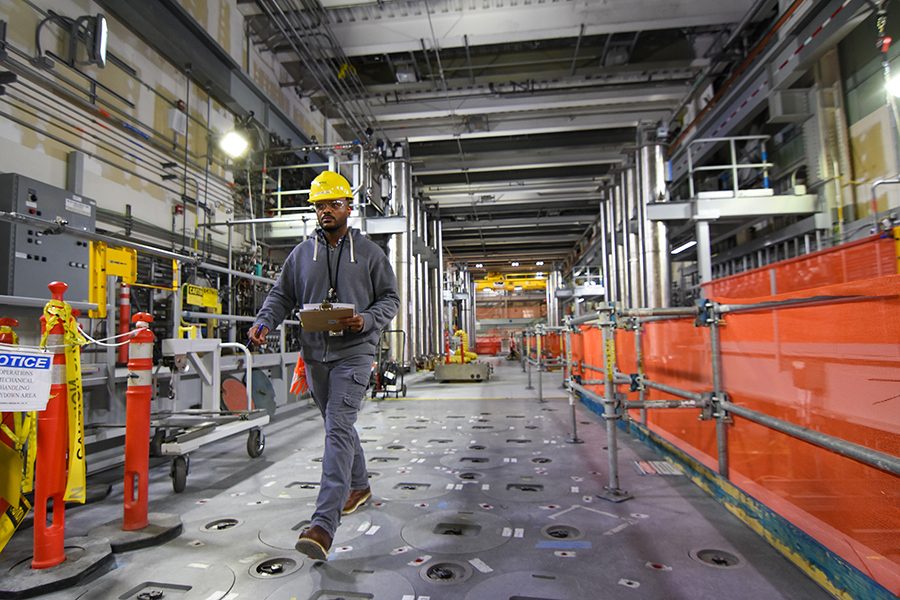
Home » Hanford remains key economic driver as new technologies emerge
Hanford 2024
Hanford remains key economic driver as new technologies emerge

Worker walks through the Direct-Feed Low-Activity Waste (DFLAW) Facility with melter.
Courtesy BechtelApril 15, 2024
One out of every 10 people in the Tri-Cities is employed by a job connected to federal funding, whether through the Hanford site, Pacific Northwest National Laboratory or with a subcontractor. This 13,000-person employment cluster’s impact on industries throughout the community remains significant.
“It has a way of uplifting everybody else, from Realtors who sell houses to residential contractors to build houses to car dealerships to hotels to movie theaters,” said Nickolas Bumpaous, president of the Central Washington Building Trades Council and business manager for UA Local Union 598 Plumbers & Steamfitters.
In the last four years, the national lab alone has added 1,000 new jobs to its workforce.
“They are generally higher income jobs and obviously that has a real kind of trickle-down effect throughout the economy,” said Karl Dye, president and CEO of the Tri-City Development Council (TRIDEC). “Those are among some of the most valuable jobs, if you will, because they create additional jobs throughout the community.”
The number of federally-funded jobs and payroll wage shares has fallen since 2020 and the start of the pandemic but the Hanford impact remains strong.
Washington State Employment Security Department lists these positions at 10.1% for the region, accounting for just over a fifth of total payroll wages, courtesy of the higher wage positions often seen with skilled roles.
In 2020, federally-funded employment accounted for a full percent more than it did in 2022, and the $1.58 billion in wages totaled nearly 23.5% of the overall salaries earned for the Benton-Franklin region.
“It’s still very important economically for us,” said David Reeploeg, TRIDEC’s vice president of federal programs, whose job it is to track these metrics.
Federal injection
Reeploeg spoke to the Tri-Cities Area Journal of Business shortly after the most recent funding for Hanford was approved in March 2024, totaling $3.05 billion for the fiscal year, a new record for Hanford – and the first time funding has topped $3 billion. Together with an estimated $1.5 billion for PNNL, Reeploeg estimated $4.5 billion in federal funding.
"That funding ensures the folks withtalent get to come use their talent in ourcommunity,” said Bumpaous, who addedthe funding also indirectly helps localbusinesses that provide ancillary supportto the site. “That is an untold number ofadditional craftspeople who could chooseto work anywhere,” he said.
 David Reeploeg | TRIDEC
David Reeploeg | TRIDEC As the cost of goods and services has increased, Hanford funding must follow along with it, and the most recent budget included an increase of more than $200 million over the previous fiscal year. That’s important for the plans to tackle important achievements in 2025, including starting the Direct-Feed Low-Activity Waste program, construction of the High-Level Waste Vitrification Facility, and possibly addressing the waste capsulation storage facility or contamination found at the 324 Building.
“You can't really do all of that even at the current funding level,” Reeploeg said.
Completing this work requires the 13,000 employees tied to federally-funded positions, including upwards of 4,000 in professional trades.
“Those are some of the most highly skilled craftspeople in the country who dedicate their talent to help solve and complete the cleanup mission,” Bumpaous said. “When you're talking about a skilled ironworker, welder, plumber or electrician, keeping that talent here in the Tri-Cities allows us to build the stuff we want to build when we want to build it. And when working-class people have a good job, they stay here in the community, they spend money, and we pass school bonds to build better schools.”
An economic driver
About 150 companies are federally funded in the Tri-Cities with the average worker of this cluster earning a salary of $125,000, compared to the $61,058 for the average wage earner in the Benton-Franklin region.
“They’re paid a wage and benefits that allow them to buy houses and cars to support the community in other ways,” Bumpaous said.
While cleanup work at Hanford is predicted to continue for decades, TRIDEC knows those jobs are valuable but shouldn’t be relied on as a sole economic driver.
“I think sometimes Hanford funding is viewed as a job creation machine, and we need to make sure we get it, and it’s all about keeping people employed,” Dye said. “But from a community aspect, our focus is on safe cleanup as rapidly and efficiently as possible and the employment that goes with that is a multiplier. We need to make sure we have the economy ready to sustain the huge progress we've made over the 80 years since the project began.”
Reeploeg said this is especially important as other sites around the U.S. Department of Energy’s Environmental Management complex are cleaned up, including sites in New Mexico, Tennessee and South Carolina. As that continues, there will be fewer members of Congress pressing for this project to remain a budget priority.
“As we approach the end of this decade, we really are going to need additional funding to keep doing all that work,” Reeploeg said. “The alternative would be that a lot of the work currently in the (U.S. Department of Energy) Richland Operations Office scope could be put on the back burner, and that's something we'd like to avoid; it's very inefficient. It increases costs in the long run for overall clean up.”
Critical diversification
TRIDEC has been a proactive player in the effort to diversify the local economy and slowly reduce the region’s reliance on the federal government, hoping to avoid the “boom and bust” seen in the 1980s and 1990s, by creating jobs in fields not directly tied to budgets approved by the U.S. Congress.
“It's been a slow, but steady, evolution,” Reeploeg said. “We have a lot of other things developing in town, whether it’s the Amazon warehouses, Darigold food processing, or the expansion of ATI in Richland. All of those things are non-federal dollars and not as impacted by economic swings or recessions since people still eat and drink.”
 Karl Dye | TRIDEC
Karl Dye | TRIDECDye said this diversification became critical during the pandemic as mandated shutdowns kept many workers off the job, it wasn’t just Hanford cleanup positions that earned that coveted classification of ‘essential,’ allowing work to continue.
“Food manufacturing, construction, kind of our ‘base’ industries were deemed essential,” Dye said. “The diversity of our jobs, that they were all being paid, were all essential and staying open was a good thing. So, even though retail and food service were closed for a period, once they opened back up, because the base was employed, it didn’t stop or slow down due to a demand for services.”
Clean energy sector
Looking to the future and the region’s reliance on Hanford, the TRIDEC team sees strong opportunities in the same part of town – but now in the clean energy sector. This new effort is expanding in north Richland, thanks to state tax breaks and the availability of land once held by DOE that could help grow the economy beyond the current Hanford impact.
“We feel there's a lot of opportunity outside of federal funding and leveraging that expertise of the small businesses who have capabilities in nuclear,” Reeploeg said. “Whether it’s in quality assurance, manufacturing supply chain or advanced nuclear fuels, the same skills and qualities a lot of those small businesses have to support work at Hanford could also be applied to the commercial nuclear industry as well.”
Bumpaous agreed: “We have a unique advantage with the wide range of skills available locally. One of the biggest conversations happening with those multibillion-dollar investments is, ‘Can we attract the skilled workforce to actually come here and build it, and then stay here to maintain it?’ And if the answer is, ‘No,’ most of the time you’ve got to pick a different site.”
Reeploeg wants to make sure those planners, including DOE, are thoughtful about decisions on land use, which may allow a clean energy park to take advantage of “colocation,” or the proximity to one another.
“When Energy Northwest builds the (commercial scale) advanced reactor,” expected to be the world’s first, “you could potentially use the steam or electricity to support industrial processes to benefit from the synergy. Our concern, though, is that the corridor is still being made available for other kinds of projects.”
TRIDEC worries proposed parameters currently require projects to be demolished at the end of Hanford cleanup. While that’s still not expected to finish for decades, the group wants to ensure this wouldn’t deter potential investment for the Tri-Cities long-term.
“It'll be really difficult to attract billion dollar-plus capital investments on land they don't own and with the date at some point in the future where it all has to be torn down,” Reeploeg said.
The state Legislature has committed $25 million to the project at Energy Northwest, estimated to cost $2.5 billion in a public-private partnership.
“This is going to be a huge opportunity for us to, again, grow and diversify the economy and we wouldn't have that capability as a community if we didn't have Hanford and the Columbia Generating Station,” Reeploeg said.
Latest News Hanford
KEYWORDS April 2024





